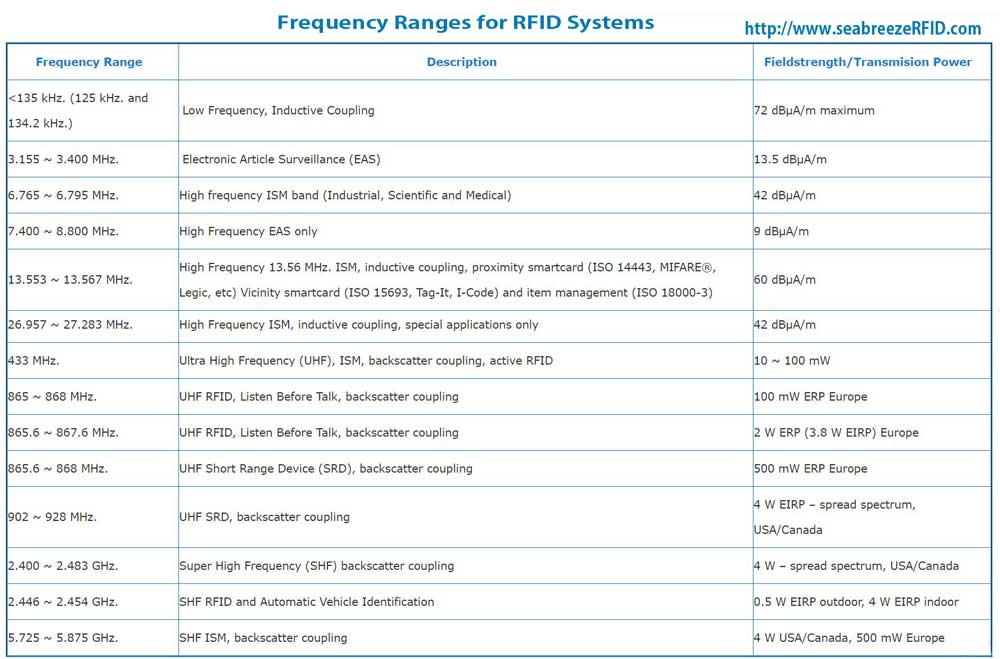RFID Frequencies and Transmission Power


Following the chart is more detailed information on UHF and EPCglobal standards by Country.

Note that in Europe there are numerous different frequencies and different maximum power regulations. Some of the European standards and the USA/Canada regulations have been adopted by other countries. When implementing an RFID system it is very important to make sure that all of the hardware meets local regulations.
Country frequency information is shown below the standards organizations information.
In order to understand the local regulations that may or may not apply, you first need to know the standards organizations and how they fit into the local RFID frequency and power transmision regulations.
International Standards Organizations
ISO – International Organization for Standardization
ITU – International Telecommunication Union
IEC – International Electrotechnical Commision
National Standards Organizations
ANSI – American National Standards Institute
BSI – British Standards Institute
Industry Standards Organizations
AIAG – Automotive Industry Action Group
EPCglobal – Electronic Product Code global – organization set up to achieve world-wide adoption and standardization of EPC technology and was a joint venture between GS1 and GS1 US, now other countries have also joined (GS1- Canada)
GS1 – Global organization dedicated to the design and standardization of global standards and solutions to imporve the efficiency and visibility of supply and demand chains
GS1 US – United States version of GS1, there are more than 100 countries that support the GS1 initiative ( GS1-Albania ~ GS1 – Vietnam)
There are three (3) ITU Regions globally:
Region 1 – Europe, North Africa, Middle East (west of the Persian Gulf), former Soviet Union
Region 2 – North and South America
Region 3 – Asia, Middle East (east of the Persian Gulf), Australia and Oceania
While the EPCglobal organization is trying to establish global standards, in many cases the ITU or other groups have already made frequency and transmission power regulations.
This makes the EPCglobal standard for UHF multi-frequency and multi-power ratings between the 860 MHz. and 960 MHz. bandwidth using FHSS (Frequency Hopping Spread Spectrum) or LBT (Listen Before Talk)
The following are the current EPCglobal standards for countries or regions starting with North America:
United Stated and Canada – 902 ~ 928 MHz
Mexico – 902 ~ 928 MHz
Puerto Rica – 902 ~ 928 MHz
Latin America – Costa Rica, Dominican Republic – 902 ~ 928 MHz
South America – Argentina, Chile, Peru, Uruguay – 902 ~ 928 MHz, Brazil – 902 ~ 907.5 MHz and 915 ~ 928 MHz, Venuezuela 922 ~ 928 MHz
Europe – 865.6 ~ 867.6 MHz. (power varies by country and region)
North Africa – 862 ~ 870 MHz
South Africa – 865.6 ~ 867.6 MHz, 915.4 ~ 919 MHz and 919.2 ~ 921 MHz.
Different power ratings and technique
Israel – 915 ~ 917 MHz
Turkey – 865.6 ~ 867.6 MHz
Tunisia – 865.6 ~ 867.6 MHz
Middle East – 862 ~ 870 MHz
United Arab Emirates – 865.6 ~ 867.6 MHz
Iran – 865 ~ 868 MHz
India – 865 ~ 867 MHz
Thailand – 920 ~ 925 MHz
Malaysia – 919 ~ 923 MHz
Philippines 918 ~ 920 MHz
Malta – 865.6 ~ 867.6 MHz
Singapore – 866 ~ 869 MHz and 920 ~ 925 MHz – Different power ratings
Vietnam – 866 ~ 869 MHz and 920 ~ 925 MHz
China – 840.5 ~ 844.5 MHz and 920.5 ~ 924.5 MHz
Hong Kong – 866 ~ 868 MHz and 920 ~ 925 MHz
Taiwan – 922 ~ 928 MHz
Korea – 910 ~ 914 MHz
Japan – 952 ~ 954 MHz and 952 ~ 955 MHz – Different power ratings and licenses
Australia – 920 ~ 926 MHz
New Zealand – 864 ~ 868 MHz